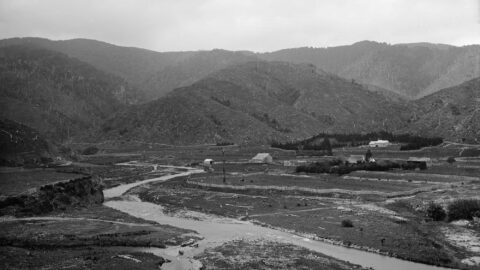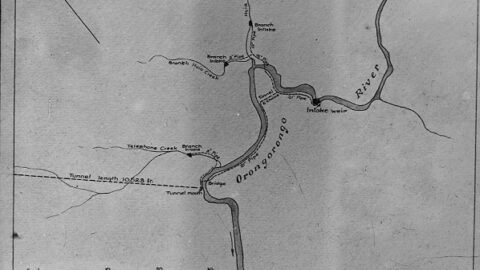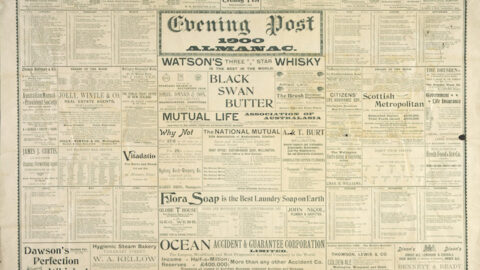HEAVY RAIN AND FLOODS.
CHIEF WATER SUPPLY CUT OFF
Portion of Wainuiomata Mains Carried Away
[BY TELEGRAPH.—PRESS ASSOCIATION]
Wellington, Tuesday.
A flood in the Hutt River swept away last night a portion of the pipe bridges used to carry the Wainuiomata mains, which convey the chief water supply to the city. About 100 feet of 24-inch mains were carried away, thus throwing the burden of the water supply for the city onto the quite inadequate Karori supply. Two spans of the bridge, each 56 feet in length, have been swept clean away. The portion of the bridge that has gone supported nine 12-foot pipes.
This morning, between the two jagged broken ends, a great quantity of muddy water was flowing, borne along with a strong current and carrying debris, large and small, on its surface. It is into this eastern channel that all the waters of the Hutt River have recently been diverted by the River Board’s protective works at Gear Island, which have dammed the western channel at both ends and constructed a stop bank down nearly the whole length of Gear Island.
The main channel for the flow of water in the eastern branch has for a long time been towards the inland bank, where the water is deepest, and the flow has always been the greatest. Here, a complete sweep has been made of 112 feet of the narrow bridge. There are still eight main spans of the structure left standing on the racecourse side. The piles of the bridge, it is said, were driven 16 feet below low water.
At the 112-foot gap, over which at one end droops one short plank of the decking, there were no signs of piles, framework, or decking in their proper position. Several experts suggested that the piles had been torn right out of the ground by the force of the water, assisted by the scour and weight of the huge logs, tree trunks, and roots that probably accumulated rapidly against the structure.
HEIGHT OF THE FLOOD
It has been known for some time that the life of the two bridges was nearing its close, and a scheme of the city engineer for the construction of a new bridge, also capable of carrying traffic, was under consideration.
The flood last night was the second highest experienced in the river since the River Board’s protective works were completed. The highest flood occurred in June 1905, when the gauge on the Hutt Bridge recorded 8 feet 6 inches. At six o’clock this morning, when the fresh was at its highest, the reading showed 8 feet. As far as the height of water goes, there has been as much water in the eastern channel on several occasions.
Probably the last person to cross the bridge before it collapsed was Mr. Clayton, the River Board’s foreman of works, who inspected the new works about midnight last night. At that time, enormous logs were coming down the river, and the water was flooding Gear Island. After completing his inspection and finding everything uninjured, he went to cross the now-demolished bridge. However, it was being buffeted and undergoing severe strain, so he hesitated for a moment. His bicycle, though, was on the further side, so he decided to cross.
He lost no time in getting across once he started. The bridge was wobbling perceptibly at that point, and he was not greatly surprised to return about six o’clock this morning to find that a portion of the structure was gone. The impression that the damage was caused by the protective works near Gear Island is disbelieved by the engineer of the River Board, who expressed the opinion that the damage was caused by logs lodging against the bridge.
THE KARORI WATER SUPPLY
With the Wainuiomata supply cut off, the Karori reservoir (which has a storage capacity of 46,000,000 gallons) now becomes an important factor in meeting the city’s water needs. Fortunately, fears for the immediate present are dispelled, as water was running to waste at Karori today. However, just two days ago, the storage supply was running out, being six feet below the normal line on Sunday.
The rain that caused damage in the Hutt has filled the Karori dam to overflowing. If more rain falls, more damage may be done to the pipe bridge, but it will also keep the Karori dam full. The Wainuiomata watershed is the city’s main source of water, with an area of 4,155 acres compared to Karori’s 110 acres. The distance from the Wainuiomata dam to the city is 17 miles, and there are 100 miles of mains carrying water.
The daily average water consumption in Wellington is reckoned at 80 gallons per head of population. The inflow into the city has been no less than 100,000 gallons an hour, making it a difficult task to maintain the supply. Meter readings last March showed that for 20 hours daily, 150,000 gallons per hour passed through the mains. During summer, Wainuiomata yields 2.5 million gallons daily compared to Karori’s 0.5 million, and even this relatively small withdrawal has seriously affected Karori’s storage during the present season.
Citizens have been urgently requested to exercise care and economy in water use. Extraordinary water users have been notified that it may be necessary to cut off their supply. “We will be lucky,” said one city officer this morning, “if we can cut down the daily supply to 2 million gallons, but a big effort in that direction will have to be made.”
The Railway Department, which draws from Wellington’s water supply, has been asked to use the Petone supply as much as possible until repairs are made. Repairs will be carried out night and day, but it will take at least three weeks under the most favourable circumstances.
The town clerk stated that if caution is exercised by citizens, there is no fear of a water famine. Later, the city engineer announced plans to turn on the supply from the Karori auxiliary reservoir to higher levels during certain hours of the night. Repairs to the Wainuiomata main are expected to take three to four weeks.
DELAYS TO SHIPPING
[BY TELEGRAPH.—PRESS ASSOCIATION]
Wellington, Tuesday.
Owing to the heavy rain yesterday, several vessels in port were unable to unload. Today, the wharves presented a very busy appearance, with as many as 27 vessels berthed, including four ocean liners.
Tags: Floods Newspaper Pipeline Waterworks




